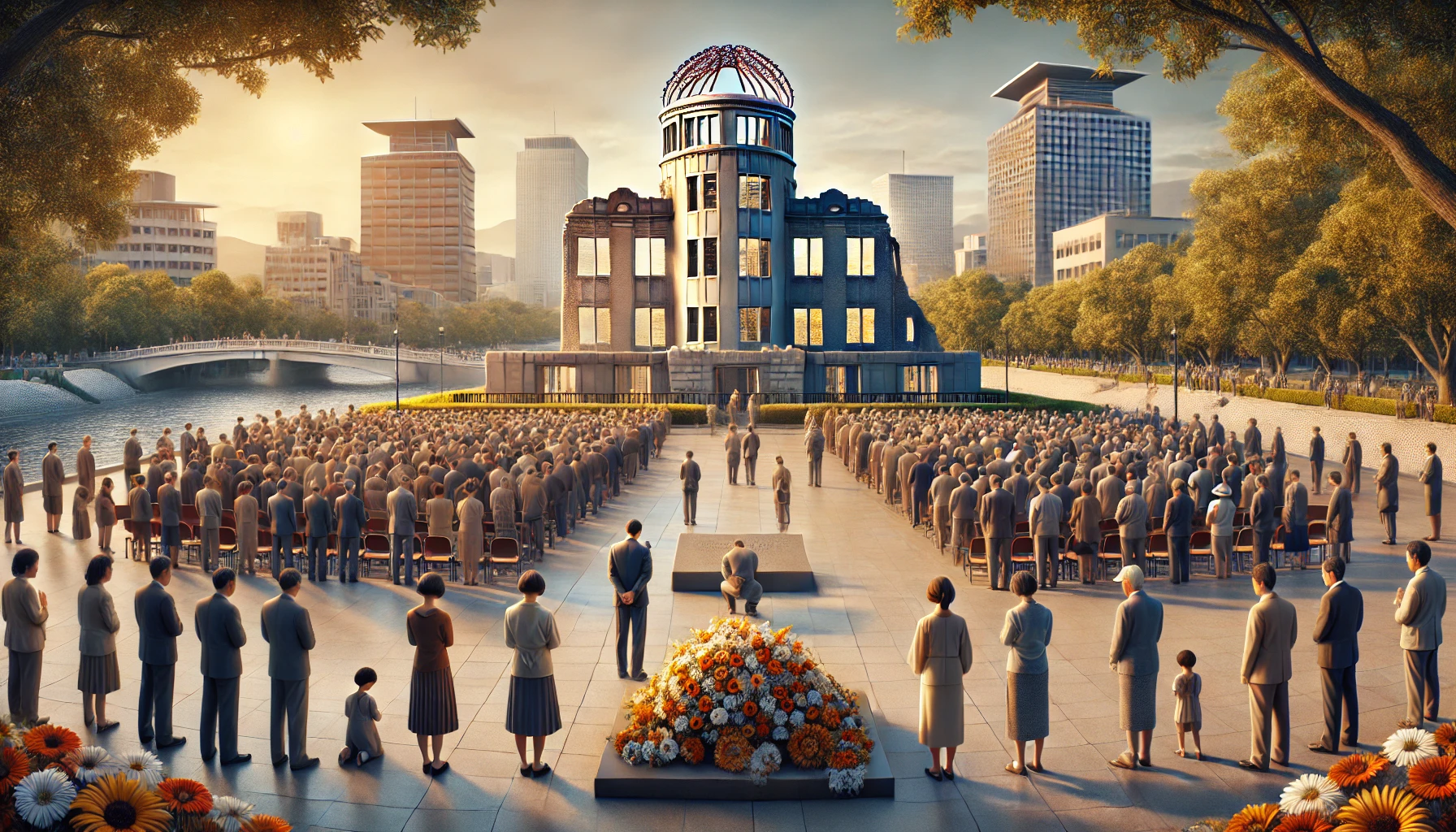
- This event has passed.
Hiroshima Day
August 6

Hiroshima Day marks a solemn commemoration on August 6 each year, honoring the lives lost during the atomic bombing of Hiroshima, Japan in 1945. This day serves as a poignant reminder of the devastating impacts of nuclear warfare and promotes a message of peace and the importance of disarmament. Educators, activists, and governments reflect on the consequences of the atomic bomb and advocate for a nuclear-free world, highlighting the need for global cooperation in achieving this goal.
The observance of Hiroshima Day involves various activities such as peace ceremonies, exhibitions, and public speeches that underscore the importance of remembering the past to prevent similar future atrocities. The day not only commemorates those who perished but also supports the survivors, known as Hibakusha, who share their harrowing experiences and serve as living testimonials to the horrors of nuclear weapons.
History and Significance of Hiroshima Day
The atomic bomb, nicknamed “Little Boy,” was dropped on Hiroshima by the United States during World War II, on August 6, 1945. This catastrophic event resulted in the immediate death of approximately 80,000 people, with tens of thousands more succumbing to injuries and radiation sickness in the following weeks. Hiroshima Day was established to acknowledge this tragic event and to foster a commitment towards ensuring that no other city or nation experiences similar suffering.
In subsequent years, Hiroshima has transformed from a symbol of devastation to one of hope and renewal. The city’s reconstruction is a testament to the resilience of its people and serves as a focal point for peace advocacy worldwide. Recognizing the profound implications of nuclear warfare, Hiroshima Day emphasizes the moral and ethical responsibilities to pursue peace and work diligently towards the elimination of nuclear weapons.
Traditions and Rituals on Hiroshima Day
In Hiroshima, the Peace Memorial Ceremony is the highlight of the day. This event is held at the Peace Memorial Park, close to the epicenter of the 1945 explosion. Attendees, including national dignitaries and citizens from around the globe, observe a moment of silence at 8:15 AM, the exact time the bomb was dropped. The ceremony is a time for reflection and is marked by the release of thousands of paper lanterns into the Motoyasu River, symbolizing the souls of the victims ascending to peace.
Educational activities also play a significant role in the day’s observances. Museums and schools around the world hold exhibitions, lectures, and presentations that delve into the impacts of nuclear weapons and the importance of peace. These educational efforts are crucial in spreading the message of Hiroshima and ensuring that the lessons of history are not forgotten.
Modern Celebration of Hiroshima Day
Today, Hiroshima Day transcends borders, with events taking place globally to advocate for peace and nuclear disarmament. Social media campaigns, peace concerts, and international conferences are commonly organized, drawing participation from a diverse audience. These modern adaptations of Hiroshima Day celebrations help to maintain the relevance of its message in a changing world and engage younger generations in peace-building efforts.
In addition to public events, digital platforms offer virtual tours of Hiroshima and Nagasaki, providing people around the world with access to the historical sites and stories of survivors. This integration of technology in commemorating Hiroshima Day plays a crucial role in educating and connecting people across different geographical and cultural backgrounds, fostering a global community committed to peace.
Congratulations and Wishes
- Wishing peace, love, and tranquility to all on this Hiroshima Day.
- May this Hiroshima Day remind us of the preciousness of life and the importance of peace.
- Let’s honor today by working towards a peaceful and just world for everyone.
- Hiroshima Day reminds us to cherish harmony and strive against conflict.
- May the memory of Hiroshima lead us toward a future of reconciliation and understanding.
- Let this Hiroshima Day be a beacon of hope for a peaceful tomorrow.
- Remembering the past to secure a peaceful future—Hiroshima Day.
- May the lessons of Hiroshima guide our actions towards peace each day.
- On Hiroshima Day, let’s renew our commitment to peace, a treasure that must be nurtured.
- Reflecting on Hiroshima Day to inspire peace and kindness in our hearts.
Unusual Facts about Hiroshima Day
- Hiroshima now has more trees than before the bombing, symbolizing rebirth.
- The Hiroshima Peace Memorial is a UNESCO World Heritage site, preserved exactly as it stood after the bombing.
- Every year, thousands of paper cranes are sent to Hiroshima from around the world as symbols of peace.
- The Flame of Peace in Hiroshima will only be extinguished once all nuclear weapons are abolished.
- Hiroshima’s Peace Memorial Park was built on an open field created by the explosion.
- Survivors of Hiroshima, known as Hibakusha, often travel the world to promote disarmament.
- The Hiroshima Peace Memorial Museum receives over a million visitors each year.
- The Children’s Peace Monument in Hiroshima was inspired by Sadako Sasaki, who believed making paper cranes would help her survive leukemia caused by radiation.
- On Hiroshima Day, television and radio in Japan often broadcast programs about the atomic bombing.
- The first Hiroshima Day was officially observed in 1947, two years after the end of WWII.
Frequently Asked Questions About Hiroshima Day
1. What exactly happened on Hiroshima Day? On August 6, 1945, the U.S. dropped an atomic bomb on the city of Hiroshima, Japan, marking the first time a nuclear weapon was used in war. The explosion caused massive destruction and significant loss of life.
2. Why do we observe Hiroshima Day? Hiroshima Day is observed to remember the victims of the atomic bombing and to promote peace and nuclear disarmament.
3. How can one participate in Hiroshima Day activities? Individuals can participate by attending commemorative events, participating in peace marches, or engaging in educational activities to learn more about the impacts of nuclear weapons.
4. Are there similar commemorations for other cities affected by nuclear attacks? Yes, Nagasaki, the second city to be bombed, is also remembered on Nagasaki Day, observed on August 9.
5. What is the significance of the paper cranes associated with Hiroshima Day? Paper cranes are a symbol of peace and hope, inspired by the story of Sadako Sasaki, a young girl who became a victim of leukemia from the radiation. She believed that folding 1,000 paper cranes would grant her a wish, according to Japanese tradition.
6. How has Hiroshima recovered since the bombing? Hiroshima has been rebuilt and is now a thriving city with a strong focus on peace and cultural significance.
7. What is the role of the Hibakusha in Hiroshima Day observances? Hibakusha play a crucial role by sharing their experiences and advocating for nuclear disarmament.
8. Is Hiroshima Day recognized internationally? Yes, Hiroshima Day is recognized globally, with many international organizations and communities holding events to commemorate the day.
9. What happens at the Peace Memorial Ceremony in Hiroshima? The ceremony includes speeches, a moment of silence at the exact time of the bombing, and the release of paper lanterns.
10. Why is the Flame of Peace in Hiroshima significant? The Flame of Peace symbolizes the hope for a world without nuclear weapons and will remain lit until all such weapons are abolished.
Conclusion: The Importance of Hiroshima Day
Hiroshima Day serves as a critical reminder of the destructive power of nuclear weapons and the human costs associated with their use. By commemorating this day, we reaffirm our commitment to peace and the importance of working towards a world free of nuclear threats. The observance encourages a reflection on our moral duties to promote peace, support disarmament initiatives, and ensure that future generations inherit a safer, more stable world.
Why Hiroshima Day Matters
Hiroshima Day underscores the need for continual dialogue and education on the consequences of nuclear warfare. It compels us to remember the past atrocities not as distant historical events but as lessons that are vitally relevant today. By engaging with this day, we not only honor those affected by the bombings but also advocate for a proactive stance against the proliferation of nuclear weapons.
Author’s Reflection on Hiroshima Day
As we observe Hiroshima Day, it’s vital to consider our roles in fostering peace and preventing future conflicts. This day should not only be about remembering a tragic past but also about taking actionable steps towards a future where such devastation can never occur again. It’s a day to educate, to reflect, and to unite in a common goal of peace and human dignity.




